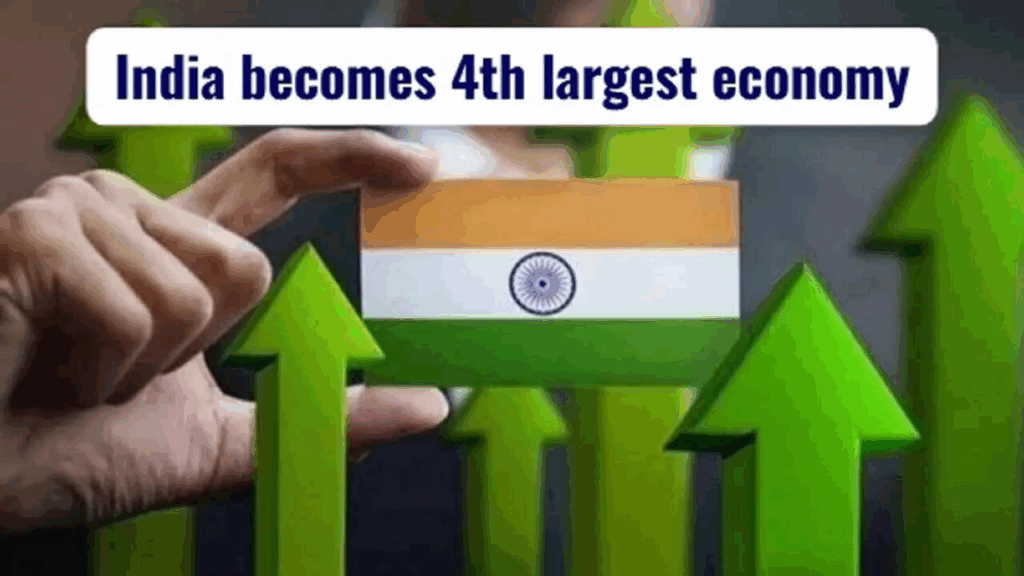India’s Economic Milestone: 4th Largest Economy in the World

Why in the News?
India has recently overtaken Japan to become the world’s fourth-largest economy in nominal GDP terms, as confirmed by the CEO of NITI Aayog in May 2025. This marks a significant moment in India’s economic journey, highlighting its growing global stature, increased economic resilience, and evolving role in international financial affairs.
While this is a cause for national pride, it also invites a deeper reflection on what such rankings imply about the actual prosperity of Indian citizens, especially when contrasted with Purchasing Power Parity (PPP) measures and per capita income indicators.
Background: India’s Evolving Economic Position
India’s economy has seen a remarkable transformation since liberalisation in 1991. From being an economy plagued by the “Hindu rate of growth” in the 1970s and 80s, it has emerged as a global player in the 21st century. This shift has been powered by structural reforms, demographic dividends, increased digitalisation, a vibrant services sector, and an expanding domestic market.
In Nominal GDP terms (USD), India has now moved ahead of Japan (which is facing a stagnant economy and demographic decline) to rank fourth globally. In PPP terms, India has been the third-largest economy since 2009, behind only the United States and China.
Understanding GDP Metrics: Nominal vs. PPP-Based GDP
To fully understand the significance of India’s rise in nominal rankings, we must understand the difference between Nominal GDP and GDP at Purchasing Power Parity (PPP).
Nominal GDP
- Definition: It is the total value of all goods and services produced in a country measured using current market exchange rates in USD.
- Example: If India’s GDP is ₹270 lakh crore and the exchange rate is $1 = ₹75, the nominal GDP = ₹270 lakh crore ÷ 75 = $3.6 trillion.
GDP at PPP
- Definition: It adjusts the GDP to reflect differences in the cost of living and price levels between countries. It captures the real value of goods and services that citizens can buy domestically.
- Example: While India’s nominal GDP might be $3.6 trillion, due to lower prices in India, PPP-adjusted GDP might be $12 trillion, reflecting greater real consumption.
Why PPP Matters:
- More accurate for comparing living standards.
- Adjusts for cost differences – a dollar goes much further in India than in the US.
- Used by multilateral institutions like the World Bank and the IMF to measure actual well-being.
India’s Position by PPP GDP
- India became the third-largest economy in PPP terms in 2009, overtaking Japan during the Manmohan Singh-led UPA government.
- Since then, it has retained this spot, despite fluctuations in nominal rankings. The PPP measure reflects India’s large population and low cost of living, boosting its effective domestic consumption and production.
Exchange Rate Effects on Nominal GDP
One of the biggest weaknesses of using nominal GDP is its sensitivity to exchange rates, which are often volatile due to geopolitical events, inflation, trade deficits, and interest rate changes.
- Examples:
- If India’s GDP is ₹300 lakh crore and $1 = ₹75, its dollar GDP = $4 trillion. But if $1 = ₹85, the same economy appears to be $3.5 trillion.
If the yen strengthens, Japan’s dollar GDP may increase even without any domestic growth.
Countries with weak or volatile currencies may seem poorer than they are, distorting global comparisons.
Thus, a nominal GDP ranking can change without any actual change in output, just due to currency fluctuations.
Per Capita GDP
A Better Lens for Prosperity?
While aggregate GDP gives a sense of a nation’s overall size and economic clout, per capita GDP – the GDP divided by the total population – is a more useful indicator of individual prosperity and living standards.
Why Per Capita GDP Matters:
Accounts for Population Size: India’s total GDP may exceed that of the UK, but India has over 20 times more people, reducing per capita income drastically.
- Reflects Living Standards: It measures average income per person, giving insight into access to housing, healthcare, education, and public services.
- Exposes Inequality: High aggregate GDP can mask internal disparities — a few billionaires may thrive while millions struggle in poverty.
Comparative Snapshot (2025 Estimates in PPP Dollars):
Thus, despite India being the 5th largest economy by nominal GDP and 3rd by PPP, its low per capita income reflects the urgent need for inclusive and equitable growth.

Key Challenges Ahead
Low Per Capita Income
- India’s per capita income remains among the lowest in G20 nations. This restricts access to quality education, healthcare, and housing — all key components of human development.High Inequality
- According to Oxfam reports and recent RBI data:
- The top 10% of Indians own over 70% of the country’s wealth.
Income inequality has worsened post-pandemic, particularly between urban and rural India. - Unemployment and Underemployment
- Despite rapid economic growth, jobless growth remains a persistent problem. The informal sector still dominates employment, with poor wages and a lack of social security.
- Inadequate Human Capital
- India ranks low on indicators such as learning outcomes, healthcare infrastructure, and digital literacy.
- Public expenditure on health (~2.1%) and education (~2.9%) of GDP is well below global averages.
Exchange Rate Vulnerability - Rupee depreciation affects external borrowing, trade competitiveness, and investor confidence. This directly impacts India’s nominal GDP rank and can overshadow real growth achievements.
Opportunities: Leveraging India’s Strengths
- Despite these challenges, India has several structural advantages:
- Young Workforce: Over 60% of the population is under 35.
- Large Domestic Market: Rapid urbanisation and a rising middle class create demand.
- Tech Ecosystem: India is a global IT hub and digital innovation leader.
- Global Supply Chain Shift: Post-COVID, companies are adopting a China+1 strategy, boosting India’s role in global manufacturing.
- Way Forward: From Economic Size to Individual Prosperity
- To translate economic growth into real prosperity, India needs strategic policy interventions that focus on human development, inclusiveness, and resilience.
Invest in Human Capital
- Increase public investment in education, healthcare, nutrition, and sanitation.
- Strengthen institutions like Skilling India, National Health Mission, and PM SHRI Schools.
- Promote digital access and AI/tech literacy to boost productivity. Ensure Equitable and Inclusive Growth
- Focus on urban poor, migrant workers, and women’s economic participation.
- Promote rural development, agrarian reforms, and support for MSMEs.
Targeted welfare schemes like PM-KISAN, Ujjwala, and Ayushman Bharat should be expanded with better implementation.
Strengthen Formalisation and Job Creation
- Expand formal job opportunities in manufacturing, logistics, renewable energy, and tourism.
- Implement labour reforms with safeguards for worker rights.
- Encourage startups, especially in Tier-2 and Tier-3 cities
- Boost Innovation and Productivity
- Invest in R&D, public-private innovation hubs, and academic-industry collaboration.
- Improve ease of doing business, reduce compliance burdens, and ensure policy predictability.
- Address Exchange Rate Sensitivities
- Build up foreign exchange reserves and diversify exports to stabilise the rupee.
Encourage local value chains and reduce import dependence in critical sectors like semiconductors, electronics, and defence.
Conclusion
India’s ascent to the position of the fourth-largest economy in nominal GDP terms is undoubtedly a proud moment. However, this should not divert attention from deeper structural issues like low per capita income, high inequality, and unemployment. Aggregate GDP is a measure of national strength, but for real prosperity, the quality of growth matters as much as the quantity.
The challenge for India is clear: To ensure that economic expansion translates into enhanced quality of life for every citizen. That requires bold investments in human capital, infrastructure, and governance reforms. If the nation can meet this challenge, it will not only be a large economy but a truly prosperous and equitable society.
MAINS PRACTICE QUESTION
Question: [UPSC 2022] Is inclusive growth possible under a market economy? State the significance of financial inclusion in achieving economic growth in India.(250 Words, 15 Marks)







